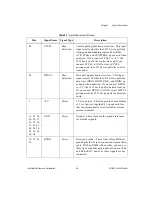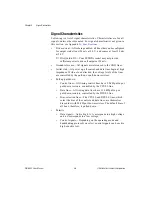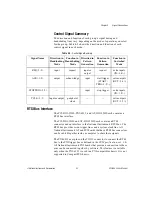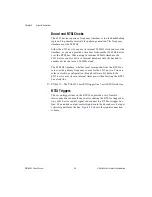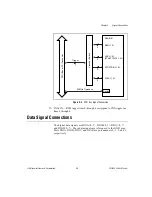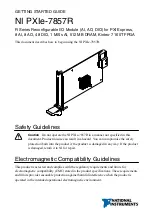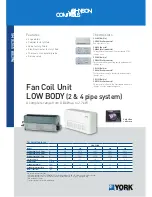
Chapter 4
Signal Connections
DIO 6533 User Manual
4-4
© National Instruments Corporation
4, 7
STOPTRIG
<1..2>
Control
Group 1 and group 2 stop triggers—You can use
rising or falling edges on these lines to end pattern
generation operations.
When not configuring the 6533 device for group
operations, you can use the STOPTRIG<1..2>
lines as extra, general-purpose input lines
(IN<1..2>).
5–6
PCLK<1..2>
Control
Group 1 and group 2 peripheral clock lines—In
handshaking mode, if you select the burst protocol,
these lines carry clock signals to the peripheral
(during output operations) or from the peripheral
device (during input operations).
When not configuring the 6533 device for group
operations, you can use the PCLK<1..2> lines as
extra, general-purpose output lines (OUT<1..2>).
10, 12–13,
15, 44–45,
47–48
DIOA<0..7>
Data
Port A bidirectional data lines—Port A is port
number 0. DIOA7 is the MSB; DIOA0 is the
LSB. When combined in a group with other ports,
port A is the least significant port.
16–17, 21–
22, 51–54
DIOB<0..7>
Data
Port B bidirectional data lines—Port B is port
number 1. DIOB7 is the MSB; DIOB0 is the LSB.
23, 25–26,
28, 57–58,
60–61
DIOC<0..7>
Data
Port C bidirectional data lines—Port C is port
number 2. DIOC7 is the MSB; DIOC0 is the LSB.
29, 31–32,
34, 63–64,
66–67
DIOD<0..7>
Data
Port D bidirectional data lines—Port D is port
number 3. DIOD7 is the MSB; DIOD0 is the
LSB. When combined in a group with other ports,
port D is the most significant port.
Table 4-1.
Signal Descriptions (Continued)
Pins
Signal Name
Signal Type
Description
















